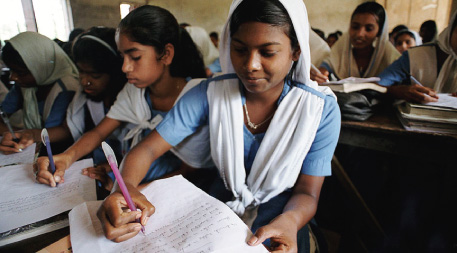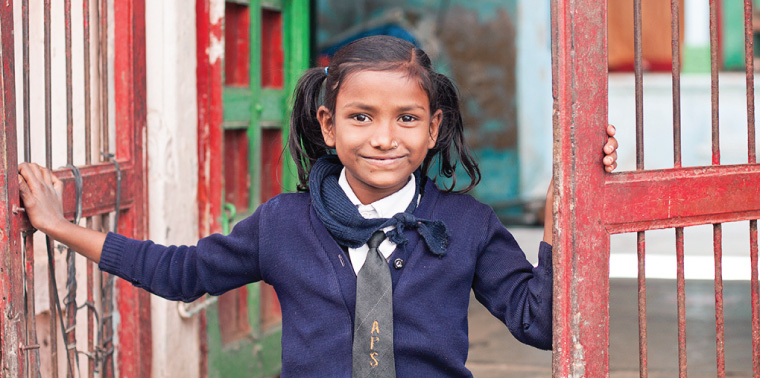April 8, 2013 — Anita grew up in Bihar, India — a country where 57 percent of girls drop out of school between the ages of 6 and 16, and only 14 percent of young women between 15 and 24 have jobs. From an early age, Anita wanted more. At 5, she begged her parents to let her go to school. At 10, she started tutoring other kids for money. By 20, she had become a beekeeper, hired her brother and trained 20 other girls in her trade, and was earning enough to pay for college.
Anita is just one girl in one country, but her story is symbolic of something much bigger: Helping girls helps the whole world. If every girl living in the developing world were given an education, a voice and a chance, according to a growing body of evidence, there would be less disease, less poverty, less pressure on the environment from overpopulation and fewer deaths at tragically young ages.
This idea — that girls are a key part of solutions to economic and social problems — has been lurking in the shadows for decades. Now, it’s going mainstream. Former U.S. secretary of state Hillary Clinton made girls and women a focus of her foreign policy efforts. And aid organizations are increasingly directing their efforts toward girls. The Nike Foundation, which has funded girl-focused projects since 2004, has even given the movement a name: “The Girl Effect.”
Girls make up 70 percent of the globe’s 130 million kids who aren’t in school.
“We have increasing amounts of data to show that if we create more of an enabling environment for girls, we really can help to change their situation, and that’s where you start to see the ripple effects — how that helps households, communities and countries,” says gender expert Sarah Degnan Kambou, interim president of the International Center for Research on Women in Washington, D.C. “Girls hold up half the sky.”
There are more than 600 million adolescent girls ages 12-18 living in developing countries, according to statistics compiled by the Nike Foundation. Of those, one in seven marries before age 15, and 38 percent become wives before age 18. Marriage often leads to motherhood, and both transitions inhibit adolescents from getting an education: Girls make up 70 percent of the globe’s 130 million kids who aren’t in school.
Just a penny out of every aid dollar goes to adolescent girls, says Michelle Chaplin, a New York-based program manager for BRAC, an international humanitarian and development organization. “They’re generally one of, if not the most vulnerable groups when it comes to developing countries,” Chaplin says, adding that it’s normal for 12-year-old girls to get pregnant in some cultures. “They’re sort of set up to repeat the same vicious cycle that their mothers went through.”
Vicious, indeed. In India, according to an ICRW survey, girls who married before age 18 were twice as likely to report that their husbands beat, slapped or threatened them. Young brides often don’t even make it that far: Compared with a woman in her early 20s, a girl under 15 is five times more likely to die from childbirth, according to the Nike Foundation. Girls between 15 and 19 are twice as likely to die as the older group.
Part of the solution, Kambou says, is for developing countries to adopt legislation that protects women by, for example, prohibiting child marriage, granting rights in the event of a husband’s death or divorce, and giving girls national identity cards that allow them to apply for business loans. On a more grassroots level, experts say, educating girls in poor communities in Asia, Africa and the Americas may be the best way to empower them to have smaller families and more options in life.
Given seven years of basic schooling, for example, a girl will marry four years later and have 2.2 fewer children, says the Nike Foundation, leading to fewer health problems and more opportunities. Offering access to family planning resources make a huge difference, too, says Malcolm Potts, director of the Bixby Center for Population, Health and Sustainability at the University of California, Berkeley. In one of the most dramatic examples, Potts says, cultural shifts in Iran recently led to a rapid decline in how many kids women had: from an average of six to two children in villages, and from four to two children in cities.
“I have never seen a situation where we have given women information and technology and they have systematically misused it,” says Potts, co-author of Sex and War: How Biology Explains War and Terrorism and Offers a Path to a Safer World. As birth rates drop, he adds, so does pressure on the environment and the proportion of angry young men in a society. “If you want to make the world a safer place, respect women and give them choices.”

Increasing the number of girls who go to secondary school by 10 percent is associated with a 3 percent growth in a country’s economy. Photo of high school girls in Suapur, Bangladesh, by Mike Wallace/World Bank (Flickr/Creative Commons).
Some of the most successful programs offer girls safe spaces of their own. In parts of Bangladesh, Tanzania and Uganda, for example, BRAC organizes girls’ groups that gather in the afternoon most days of the week. During some meetings, teens and preteens simply play soccer, read books, or sing and dance. Other days, they learn about pregnancy prevention, HIV and the importance of education. The girls practice life skills, receive job training and sometimes get small business loans. Groups also address the attitudes of parents and community leaders — including boys and men.
The results of programs like these are striking. After five years of community-based work in India, ICRW measured a full year delay in a girl’s average age of marriage — from 16 to 17. Girls who have been through BRAC programs, likewise, want to stay in school longer, Chaplin says. They have hope.
Once the world opens up to girls, the Nike Foundation says, they invest 90 percent of their income in their families, compared to the 30 to 40 percent that men contribute.
“When I went to visit one of the clubs in Bangladesh, all the girls were telling me they wanted to be doctors, lawyers and teachers,” she says. “One girl wanted to be a pilot. If you asked a kid in rural Bangladesh who didn’t have this opportunity, [she] might want to be a housewife, maybe work in her mother’s store or tend the garden. The difference in aspirations is stark.”
Once the world opens up to girls, the Nike Foundation says, they invest 90 percent of their income in their families, compared to the 30 to 40 percent that men contribute. From there, the benefits multiply. Increasing the number of girls who go to secondary school by 10 percent, according to the foundation, is associated with a 3 percent growth in a country’s economy.
Even small changes make big differences. In a video posted on The Girl Effect’s YouTube channel, a 17-year old Bangladeshi girl named Sanchita Rani Das explains how a $60 loan allowed her to buy a calf, plant a vegetable patch and start making profits. Now, she is paying for her brother’s education, covering some of her family’s expenses and putting extra money into savings.
“I know that today’s children are tomorrow’s future,” Sanchita says. “I am actually saving for my future.” ![]()
A version of this feature originally appeared in the Summer 2010 issue of Momentum magazine, Ensia’s predecessor.
Ensia shares solutions-focused stories free of charge through our online magazine and partner media. That means audiences around the world have ready access to stories that can — and do — help them shape a better future. If you value our work, please show your support today.
Yes, I'll support Ensia!
